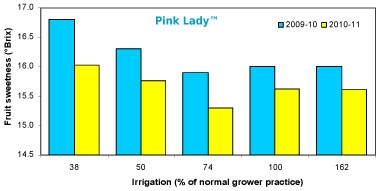Improving fruit quality, and increasing consumer awareness that horticultural produce is a good source of antioxidants, could be a differentiation trait for Australian horticulture.
Fruit quality can be manipulated through orchard management practices such as irrigation or crop load.
Scientists at DPI in Victoria in collaboration with the University of Tasmania, investigated the effects on yield, quality and composition of Pink Lady™ and Royal Gala apples, of deficit irrigation (Goulburn Valley, Victoria) and crop load (Huon Valley, Tasmania)*.
Fruit size, sweetness and antioxidant content were measured in response to both low and high irrigation or crop load treatments.
Experiments
Irrigation
Irrigation experiments on Royal Gala and Pink Lady commenced in 2008–09 and 2009–10 seasons, respectively.
Five irrigation treatments were applied as a percentage of grower irrigation practice: 38, 50, 74, 100, 162%.
Irrigation amount was varied by changing the irrigation application rate of the drippers along the irrigation lines. All irrigation treatments were operated for the same run-time.
Royal Gala data for 2010–11 is not reported in this article as no significant irrigation was applied due to excessive rainfall.
Crop load
The crop load experiment in Tasmania was performed in 2009–10 season by manually adjusting tree crop load to 50 t/ha—considered the normal crop load of the district—and to 80 t/ha, a high crop load treatment.
Sweetness & antioxidants
Sweetness (soluble solids content, SSC, °Brix) and antioxidant status of the fruit (total plant polyphenols, TPP, mg gallic acid equivalent/g fresh weight) were measured on a sample of 10 fruit from each experimental plot.
Fruit samples from the crop load experiment were shipped in a refrigerated container from Tasmania to DPI Knoxfield where the same analyses described above were performed.
Results
Fruit size
Fruit size was significantly reduced by deficit irrigation (as previously reported in Tree Fruit May 2012). The same trend was observed in both varieties.
Irrigation treatments had no significant impact on fruit number (Table 1).
Increasing crop load did not have an impact on fruit size on both varieties in the considered year (Table 2).
Fruit sweetness
Deficit irrigation significantly increased fruit sweetness on both varieties, as measured by total soluble solids (TSS, °Brix).
There appeared to be a negative relationship between the volume of water delivered to the trees and fruit sweetness in both varieties with 38% irrigation volume having the highest °Brix value (Figure 1 and 2).
Pink Lady showed higher °Brix than Royal Gala.
Increasing crop load had no effect on fruit sweetness in Royal Gala and only a slight (non-significant) reduction in Pink Lady (Table 2).
Antioxidant levels
A similar trend to fruit sweetness was observed in Royal Gala regarding antioxidants, as measured by total plant polyphenols (TPP, mg gallic acid equivalents per g fresh weight).
Decreasing irrigation below 74% of grower practice resulted in an increase in antioxidant concentration (Figure 3).
A similar response in Pink Lady occurred in the 2009–10 (Figure 4).
In contrast, antioxidant concentration tended to increase with increases in irrigation amount in Pink Lady during the 2010–11 season, however, these differences were not significant.
Interesting observation
An interesting observation found in both varieties and years, apart from the 2010–11 season due to excessive rainfall, was that reducing irrigation to 74% of normal irrigation practice showed the lowest value of antioxidant concentration—implying that at this irrigation level there could be a physiological threshold in the biochemical pathway.
Crop load did not show any effect on antioxidant concentration in the fruit for both varieties.
Conclusion
Reducing irrigation increased fruit sweetness.
Reducing irrigation below 75% of grower irrigation practice increased antioxidant concentration (as measured by total plant polyphenols).
Crop load levels did not have any effect on fruit sweetness and antioxidant concentration.
From our research it could be concluded that there is the potential to produce apples with higher antioxidant and TSS content by reducing irrigation below 75% of normal irrigation practice, however, considering that reducing irrigation reduces fruit size, and that the crop load experiment investigated only an increase in fruit number, it is currently not possible to fully determine if reducing fruit number on the trees subjected to water reduction would compensate for the reduced fruit size.
Additional research is necessary to investigate a greater range in crop load and, interaction of crop load with irrigation.
Possible differentiation trait
Increased sugar and antioxidant concentration in apples through irrigation management could become a differentiation trait for Australian horticulture in national and international markets and possibly obtain a price premium at the farm gate.
*This project was conducted as part of the Premium Fruits project and the apple and pear industry Productivity Irrigation Pests and Soils (PIPS) flagship program, funded by HAL using the apple and pear industry levy and matched funds from the Australian Government. Additional financial support was provided by DPI Victoria.
For all the graphs, see Tree Fruit March 2013






















